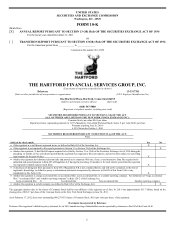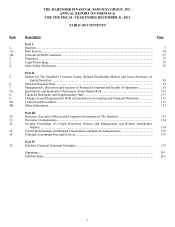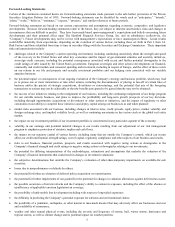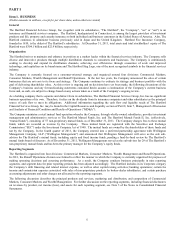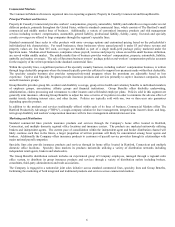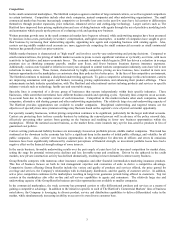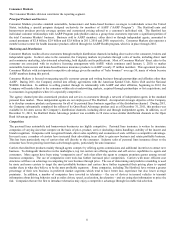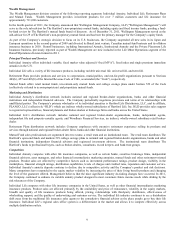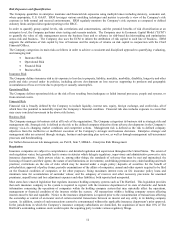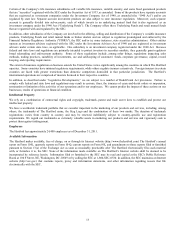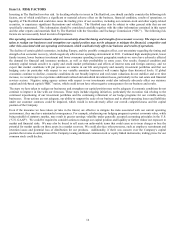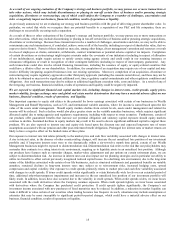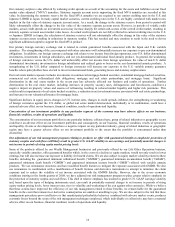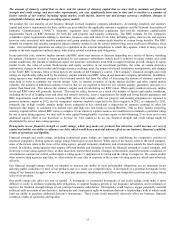The Hartford 2011 Annual Report Download - page 7
Download and view the complete annual report
Please find page 7 of the 2011 The Hartford annual report below. You can navigate through the pages in the report by either clicking on the pages listed below, or by using the keyword search tool below to find specific information within the annual report.7
Competition
In the small commercial marketplace, The Hartford competes against a number of large national carriers, as well as regional competitors
in certain territories. Competitors include other stock companies, mutual companies and other underwriting organizations. The small
commercial market has become increasingly competitive as favorable loss costs in the past few years have led carriers to differentiate
themselves through product expansion, price reduction, enhanced service and cutting-edge technology. Larger carriers such as The
Hartford have improved their pricing sophistication and ease of doing business with agents through the use of predictive modeling tools
and automation which speeds up the process of evaluating a risk and quoting new business.
Written premium growth rates in the small commercial market have begun to rebound, while underwriting margins have been pressured
by increases in loss costs, particularly in workers’ compensation, and higher catastrophes. A number of companies have sought to grow
their business by increasing their underwriting appetite, appointing new agents and expanding business with existing agents. Also,
carriers serving middle market-sized accounts are more aggressively competing for small commercial accounts as small commercial
business has generally been less price-sensitive.
Middle market business is characterized as "high touch" and involves case-by-case underwriting and pricing decisions. Compared to
small commercial lines, the pricing of middle market accounts is prone to more significant variation or cyclicality over time, with more
sensitivity to legislative and macro-economic forces. The economic downturn which began in 2008 has driven a reduction in average
premium size as shrinking company payrolls, smaller auto fleets, and fewer business locations depress insurance exposures.
Additionally, various state legislative reforms in recent years designed to control workers compensation indemnity costs have led to rate
reductions in many states. These factors, characterized by highly competitive pricing on new business, have resulted in more new
business opportunities in the marketplace as customers shop their policies for a better price. In the face of this competitive environment,
The Hartford continues to maintain a disciplined underwriting approach. To gain a competitive advantage in this environment, carriers
are improving automation with agents and brokers, increasing pricing sophistication, and enhancing their product offerings. These
enhancements include industry specialization, with The Hartford and other national carriers tailoring products and services to specific
industry verticals such as technology, health care and renewable energy.
Specialty lines is comprised of a diverse group of businesses that operate independently within their specific industries. These
businesses, while somewhat interrelated, have different business models and operating cycles. Specialty lines competes on an account-
by-account basis due to the complex nature of each transaction. Competition in this market includes other stock companies, mutual
companies, alternative risk sharing groups and other underwriting organizations. The relatively large size and underwriting capacity of
The Hartford provides opportunities not available to smaller companies. Disciplined underwriting and targeted returns are the
objectives of specialty lines since premium writings may fluctuate based on the segment’ s view of perceived market opportunity.
For specialty casualty businesses, written pricing competition continues to be significant, particularly for the larger individual accounts.
Carriers are protecting their in-force casualty business by initiating the renewal process well in advance of the policy renewal date,
effectively preventing other carriers from quoting on the business and resulting in fewer new business opportunities within the
marketplace. Within the national account business, as the market firms, more insureds may opt for loss-sensitive products in lieu of
guaranteed cost policies.
Carriers writing professional liability business are increasingly focused on profitable private, middle market companies. This trend has
continued as the downturn in the economy has led to a significant drop in the number of initial public offerings, and volatility for all
public companies. Also, carriers’ new business opportunities in the marketplace for directors & officers and errors & omissions
insurance have been significantly influenced by customer perceptions of financial strength, as investment portfolio losses have had a
negative effect on the financial strength ratings of some insurers.
In the surety business, favorable underwriting results over the past couple of years have led to increased competition for market share,
setting the stage for potential written price declines and less favorable terms and conditions. Driven by the upheaval in the credit
markets, new private construction activity has declined dramatically, resulting in lower demand for contract surety business.
Group Benefits competes with numerous other insurance companies and other financial intermediaries marketing insurance products.
This line of business focuses on both its risk management expertise and economies of scale to derive a competitive advantage.
Competitive factors affecting Group Benefits include the variety and quality of products and services offered, the price quoted for
coverage and services, the Company’ s relationships with its third-party distributors, and the quality of customer service. In addition,
active price competition continues in the marketplace resulting in longer rate guarantee periods being offered to customers. Top tier
carriers in the marketplace also offer on-line and self service capabilities to agents and consumers. The relatively large size and
underwriting capacity of the Group Benefits business provides opportunities not available to smaller companies.
In the commercial marketplace, the weak economy has prompted carriers to offer differentiated products and services as a means of
gaining a competitive advantage. In addition to the initiatives specific to each of The Hartford’ s Commercial Markets’ lines of business
noted above, the Company is leveraging its diverse product, service and distribution capabilities to deliver differentiated value in the
market, while simultaneously increasing its ability to access to its own diverse customer base.

